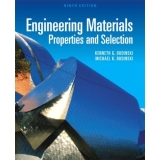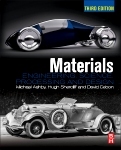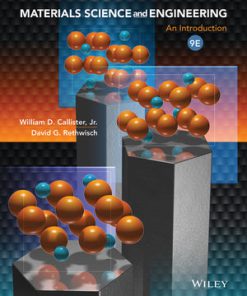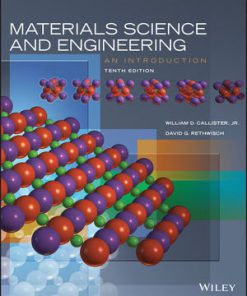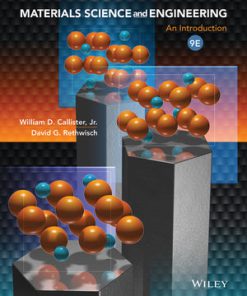Materials Science and Engineering: An Introduction Callister 8th Edition Solutions Manual
$35.00 Original price was: $35.00.$26.50Current price is: $26.50.
Materials Science and Engineering: An Introduction Callister 8th Edition Solutions Manual
Instant download Materials Science and Engineering: An Introduction Callister 8th Edition Solutions Manual pdf docx epub after payment.
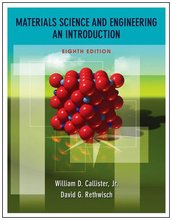
Product details:
- ISBN-10 : 0470419970
- ISBN-13 : 978-0470419977
- Author: William D. Calliste; David G. Rethwisch
Building on the success of previous editions, this book continues to provide engineers with a strong understanding of the three primary types of materials and composites, as well as the relationships that exist between the structural elements of materials and their properties. The relationships among processing, structure, properties, and performance components for steels, glass-ceramics, polymer fibers, and silicon semiconductors are explored throughout the chapters. The discussion of the construction of crystallographic directions in hexagonal unit cells is expanded. At the end of each chapter, engineers will also find revised summaries and new equation summaries to reexamine key concepts.
Table of contents:
List of Symbols. 1 Introduction.
Learning Objectives.
1.1 Historical Perspective.
1.2 Materials Science and Engineering.
1.3 Why Study Materials Science and Engineering?
1.4 Classification of Materials.
1.5 Advanced Materials.
1.6 Modern Materials’ Needs.
1.7 Processing/Structure/Properties/Performance Correlations.
Summary.
References.
Question.
2 Atomic Structure and Interatomic Bonding.
Learning Objectives.
2.1 Introduction.
Atomic Structure.
2.2 Fundamental Concepts.
2.3 Electrons in Atoms.
2.4 The Periodic Table.
Atomic Bonding in Solids.
2.5 Bonding Forces and Energies.
2.6 Primary Interatomic Bonds.
2.7 Secondary Bonding or van der Waals Bonding.
2.8 Molecules.
Summary.
Equation Summary.
Processing/Structure/Properties/Performance Summary.
Important Terms and Concepts.
References.
Questions and Problems.
3 The Structure of Crystalline Solids.
Learning Objectives.
3.1 Introduction.
Crystal Structures.
3.2 Fundamental Concepts.
3.3 Unit Cells.
3.4 Metallic Crystal Structures.
3.5 Density Computations.
3.6 Polymorphism and Allotropy.
3.7 Crystal Systems.
Crystallographic Points, Directions, and Planes.
3.8 Point Coordinates.
3.9 Crystallographic Directions.
3.10 Crystallographic Planes.
3.11 Linear and Planar Densities.
3.12 Close-Packed Crystal Structures.
Crystalline and Noncrystalline Materials.
3.13 Single Crystals.
3.14 Polycrystalline Materials.
3.15 Anisotropy.
3.16 X-Ray Diffraction: Determination of Crystal Structures.
3.17 Noncrystalline Solids.
Summary.
Equation Summary.
Processing/Structure/Properties/Performance Summary.
Important Terms and Concepts.
References.
Questions and Problems.
4 Imperfections in Solids.
Learning Objectives.
4.1 Introduction.
Point Defects.
4.2 Vacancies and Self-Interstitials.
4.3 Impurities in Solids.
4.4 Specification of Composition.
Miscellaneous Imperfections.
4.5 Dislocation–Linear Defects.
4.6 Interfacial Defects.
4.7 Bulk or Volume Defects.
4.8 Atomic Vibrations.
Microscopic Examination.
4.9 Basic Concepts of Microscopy.
4.10 Microscopic Techniques.
4.11 Grain Size Determination.
Summary.
Equation Summary.
Processing/Structure/Properties/Performance Summary.
Important Terms and Concepts.
References.
Questions and Problems.
Design Problems.
5 Diffusion.
Learning Objectives.
5.1 Introduction.
5.2 Diffusion Mechanism.
5.3 Steady-State Diffusion.
5.4 Nonsteady-State Diffusion.
5.5 Factors That Influence Diffusion.
5.6 Diffusion in Semiconducting Materials.
5.7 Other Diffusion Paths.
Summary.
Equation Summary.
Processing/Structure/Properties/Performance Summary.
Important Terms and Concepts.
References.
Questions and Problems.
Design Problems.
6 Mechanical Properties of Metals.
Learning Objectives.
6.1 Introduction.
6.2 Concepts of Stress and Strain.
Elastic Deformation.
6.3 Stress-Strain Behavior.
6.4 Anelasticity.
6.5 Elastic Properties of Materials.
Plastic Deformation.
6.6 Tensile Properties.
6.7 True Stress and Strain.
6.8 Elastic Recovery After Plastic Deformation.
6.9 Compressive, Shear, and Torsional Deformations.
6.10 Hardness.
Property Variability and Design/Safety Factors.
6.11 Variability of Material Properties.
6.12 Design/Safety Factors.
Summary.
Equation Summary.
Processing/Structure/Properties/Performance Summary.
Important Terms and Concepts.
References.
Questions and Problems.
Design Problems.
7 Dislocations and Strengthening Mechanisms.
Learning Objectives.
7.1 Introduction.
Dislocations and Plastic Deformation.
7.2 Basic Concepts.
7.3 Characteristics of Dislocations.
7.4 Slip Systems.
7.5 Slip in Single Crystals.
7.6 Plastic Deformation of Polycrystalline Materials.
7.7 Deformation by Twinning.
Mechanism of Strengthening in Metals.
7.8 Strengthening by grain Size Reduction.
7.9 Solid-Solution Strengthening.
7.10 Strain Hardening.
Recovery, Recrystallization, and Grain Growth.
7.11 Recovery.
7.12 Recrystallization.
7.13 Grain Growth.
Summary.
Equation Summary.
8 Failure.
Learning Objectives.
8.1 Introduction.
Fracture.
8.2 Fundamentals of Fracture.
8.3 Ductile Fracture.
8.4 Brittle Fracture.
8.5 Principles of Fracture Mechanics.
8.6 Fracture Toughness Testing.
Fatigue.
8.7 Cyclic Stresses.
8.8 The S–N Curve.
8.9 Crack Initiation and Propagation.
8.10 Factors That Affect Fatigue Life.
8.11 Environmental Effects.
Creep.
8.12 Generalized Creep Behavior.
8.13 Stress and Temperature Effects.
8.14 Data Extrapolation Methods.
8.15 alloys for High-Temperature Use.
Summary.
Equation Summary.
Processing/Structure/Properties/Performance Summary.
Important Terms and Concepts.
References.
Questions and Problems.
Design Problems.
9 Phase Diagrams.
Learning Objectives.
9.1 Introduction.
Definitions and Basic Concepts.
9.2 Solubility Limit.
9.3 Phases.
9.4 Microstructure.
9.5 Phase Equilibria.
9.6 One-Component (or Unary) Phase Diagrams.
Binary Phase Diagrams.
9.7 Binary Isomorphous Systems.
9.8 Interpretation of Phase Diagrams.
9.9 Development of Microstructure in Isomorphous Alloys.
9.10 Mechanical Properties of Isomorphous Alloys.
9.11 Binary Eutectic Systems.
9.12 Development of Microstructure in Eutectic Alloys.
9.13 Equilibrium Diagrams Having Intermediate Phases or Compounds.
9.14 Eutectoid and Peritectic Reactions.
9.15 Congruent Phase Transformations.
9.16 Ceramic and Ternary Phase Diagrams.
9.17 The Gibbs Phase Rule.
The Iron–Carbon System.
9.18 The Iron–Iron Carbide (Fe–Fe3C) Phase Diagram.
9.19 Development of Microstructure in Iron–Carbon Alloys.
9.20 The Influence of Other Alloying Elements.
Summary.
Equation Summary.
Processing/Structure/Properties/Performance Summary.
Important Terms and Concepts.
References.
Questions and Problems.
10 Phase Transformations in Metals: Development of Microstructure and Alteration of Mechanical Properties.
Learning Objectives.
10.1 Introduction.
10.2 Basic Concepts.
10.3 The Kinetics of Phase Transformations.
10.4 Metastable Versus Equilibrium States.
10.5 Isothermal Transformation Diagrams.
10.6 Continuous Cooling Transformation Diagrams.
10.7 Mechanical Behavior of Iron–Carbon Alloys.
10.8 Tempered Martensite.
10.9 Review of Phase Transformations and Mechanical Properties for Iron–Carbon Alloys.
Summary.
Equation Summary.
Processing/Structure/Properties/Performance Summary.
Important Terms and Concepts.
References.
Questions and Problems.
Design Problems.
11 Applications and Processing of Metal Alloys.
Learning Objectives.
11.1 Introduction.
Types of Metal Alloys.
11.2 Ferrous Alloys.
11.3 Nonferrous Alloys.
Fabrication of Metals.
11.4 Forming Operations.
11.5 Casting.
11.6 Miscellaneous Techniques.
Thermal Processing of Metals.
11.7 Annealing Processes.
11.8 Heat Treatment of Steels.
11.9 Precipitation Hardening.
Summary.
Equation Summary.
Processing/Structure/Properties/Performance Summary.
Important Terms and Concepts.
References.
Questions and Problems.
Design Problems.
12 Structures and Properties of Ceramics.
Learning Objectives.
12.1 Introduction.
Ceramic Structures.
12.2 Crystal Structures.
12.3 Silicate Ceramics.
12.4 Carbon.
12.5 Imperfections in Ceramics.
12.6 Diffusion in Ionic Materials.
12.7 Ceramic Phase Diagrams.
Mechanical Properties.
12.8 Brittle Fracture of Ceramics.
12.9 Stress–Strain Behavior.
12.10 Mechanisms of Plastic.
12.11 Miscellaneous Mechanical Considerations.
Summary.
Equation Summary.
Processing/Structure/Properties/Performance Summary.
Important Terms and Concepts.
References.
Questions and Problems.
Design Problems.
13 Applications and Processing of Ceramics.
Learning Objectives.
13.1 Introduction.
Types and Applications of Ceramics.
13.2 Glasses.
13.3 Glass-Ceramics.
13.4 Clay Products.
13.5 Refractories.
13.6 Abrasives.
13.7 Cements.
13.8 Advanced Ceramics.
Fabrication and Processing of Ceramics.
13.9 Fabrication and Processing of Glasses and Glass-Ceramics.
13.10 Fabrication and Processing of Clay Products.
13.11 Powder Pressing.
13.12 Tape Casting.
Summary.
Equation Summary.
Processing/Structure/Properties/Performance Summary.
Important Terms and Concepts.
References.
Questions and Problems.
Design Problem.
14 Polymer Structures.
Learning Objectives.
14.1 Introduction.
14.2 Hydrocarbon Molecules.
14.3 Polymer Molecules.
14.4 The Chemistry of Polymer Molecules.
14.5 Molecular Weight.
14.6 Molecular Shape.
14.7 Molecular Structure.
14.8 Molecular Configurations.
14.9 Thermoplastic and Thermosetting Polymers.
14.10 Copolymers.
14.11 Polymer Crystallinity.
14.12 Polymer Crystals.
14.13 Defects in Polymers.
14.14 Diffusion in Polymeric Materials.
Summary.
Equation Summary.
Processing/Structure/Properties/Performance Summary.
Important Terms and Concepts.
References.
Questions and Problems.
15 Characteristics, Applications, and Processing of Polymers.
Learning Objectives.
15.1 Introduction.
Mechanical Behavior of Polymers.
15.2 Stress–Strain Behavior.
15.3 Macroscopic Deformation.
15.4 Viscoelastic Deformation.
15.5 Fracture of Polymers.
15.6 Miscellaneous Mechanical Characteristics.
Mechanism of Deformation and for Strengthening of Polymers.
15.7 Deformation of Semicrystalline Polymers.
15.8 Factors That Influence the Mechanical Properties of Semicrystalline Polymers.
15.9 Deformation of Elastomers.
Crystallization, Melting, and Glass Transition Phenomena in Polymers.
15.10 Crystallization.
15.11 Melting.
15.12 The Glass Transition.
15.13 Melting and Glass Transition Temperatures.
15.14 Factors That Influence Melting and Glass Transition Temperatures.
Polymer Types.
15.15 Plastics.
15.16 Elastomers.
15.17 Fibers.
15.18 Miscellaneous Applications.
15.19 Advanced Polymeric Materials.
Polymer Synthesis and Processing.
15.20 Polymerization.
15.21 Polymer Additives.
15.22 Forming Techniques for Plastics.
15.23 Fabrication of Elastomers.
15.24 Fabrication of Fibers and Films.
Summary.
Equation Summary.
Processing/Structure/Properties/Performance Summary.
Important Terms and Concepts.
References.
Questions and Problems.
Design Questions.
16 Composites.
Learning Objectives.
16.1 Introduction.
Particle-Reinforced Composites.
16.2 Large-Particle Composites.
16.3 Dispersion-Strengthened Composites.
Fiber-Reinforced Composites.
16.4 Influence of Fiber Length.
16.5 Influence of Fiber Orientation and Concentration.
16.6 The Fiber Phase.
16.7 The Matrix Phase.
16.8 Polymer-Matrix Composites.
16.9 Metal-Matrix Composites.
16.10 Ceramic-Matrix Composites.
16.11 Carbon–Carbon Composites.
16.12 Hybrid Composites.
16.13 Processing of fiber-Reinforced Composites.
Structural Composites
16.14 Laminar Composites.
16.15 Sandwich Panels.
Summary.
Equation Summary.
Processing/Structure/Properties/Performance Summary.
Important Terms and Concepts.
References.
Questions and Problems.
Design Problems.
17 Corrosion and Degradation of Materials.
Learning Objectives.
17.1 Introduction.
Corrosion of Metals.
17.2 Electrochemical Considerations.
17.3 Corrosion Rates.
17.4 Prediction for Corrosion Rates.
17.5 Passivity.
17.6 Environmental Effects.
17.7 Forms of Corrosion.
17.8 Corrosion Environments.
17.9 Corrosion Prevention.
17.10 Oxidation.
Corrosion of Ceramic Materials.
Degradation of Polymers.
17.11 Swelling and Dissolution.
17.12 Bond Rupture.
17.13 Weathering.
Summary.
People also search:
Materials Science and Engineering: An Introduction
Materials Science and Engineering: An Introduction Callister Rethwisch
Materials Science and Engineering: An Introduction Callister Rethwisch 8th
Materials Science and Engineering: An Introduction Callister Rethwisch 8th Solutions Manual
Materials Science and Engineering: An Introduction Callister 8th Edition Solutions Manual
You may also like…
Solution Manual
Solution Manual for Introduction to Materials Science and Engineering A Guided Inquiry by Douglas
Solution Manual
Solution Manual
Solution Manual
Solution Manual
Solution Manual for Materials Science and Engineering An Introduction 10th by Callister
Solution Manual





